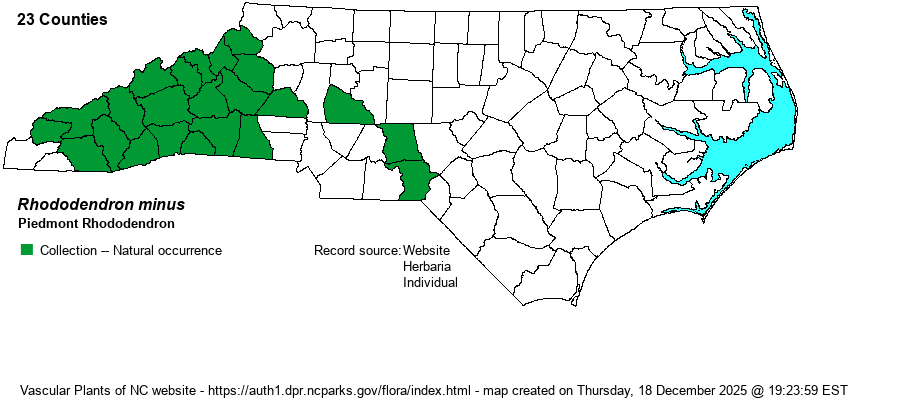| Section 6 » Order Ericales » Family Ericaceae |
Show/Hide Synonym
| taxonName | relationship | relatedTaxonName | relatedTaxonRefText | relComments |
|---|
|
|
|
| Rhododendron minus | < | Rhododendron minus | Radford, Ahles, and Bell (1968) | | | Rhododendron minus | < | Rhododendron minus | | | | Rhododendron minus | < | Rhododendron minus | Wofford (1989) | (also see R. carolinianum) | | Rhododendron minus | < | Rhododendron minus var. minus | Flora of North America (1993b, 1997, 2000, 2002a, 2002b, 2003a, 2004b, 2005, 2006a, 2006b, 2006c, 2007a, 2009, 2010) | | | Rhododendron minus | < | Rhododendron minus var. minus | | | | Rhododendron minus | < | Rhododendron minus var. minus | Stevens et al. in Kubitzki (2004). | | | Rhododendron minus | < | Rhododendron minus var. minus | Stevens et al. in Kubitzki (2004). | | | Source: Weakley's Flora |
|
| Author | Michaux | |
| Distribution | Occurs over nearly all of the Mountains, except absent from the northern tier of counties. Also present in the Piedmont foothills (except near the VA line), and disjunct east to the edge of the Piedmont in Montgomery and Richmond counties.
This species, formerly included with R. carolinianum in a single species, occurs only in the Southern Appalachians and foothills, with scattered records well into the Coastal Plain in GA and AL. Its range does not reach VA, but it does occur into southeastern KY.
| |
| Abundance | Fairly common, at least locally, in the Mountains. Much less common eastward, but may be locally fairly common in some foothills sites in the southwestern Piedmont. Generally rare and very local farther southeastward to Richmond County. | |
| Habitat | This shrub is most widespread and numerous in cool, moist, rocky ravines in the lower Mountains and foothills, especially in the Gorges region of Transylvania County; but it also occurs on high elevation rocky slopes and granitic domes. It is more of a species of the Blue Ridge Escarpment slopes than is Rhododendron carolinianum, which is found mostly west of the Blue Ridge. In the southwestern Sandhills, it occurs strictly on steep bluffs – mainly along Marks Creek in Richmond County. |
| Phenology | Blooms from late April (in the Coastal Plain and Piedmont) to early June in the higher mountains – somewhat later than the similar Carolina Rhododendron in the same areas. Fruits in September and October. | |
| Identification | This evergreen shrub is very similar to Carolina Rhododendron and has only recently been split from that species by taxonomists. Both have medium-sized, elliptical evergreen leaves with brown dots on the lower sides of the leaves, which are used to separate them from Mountain Laurel (Kalmia latifolia) (which has no such dots) when not in bloom. This species blooms slightly later than Carolina Rhododendron, even though it averages growing at lower elevations. Also, its flowers are slightly larger than are those of the Carolina Rhododendron. You likely will need to refer to identification keys in reference books for conclusive identification of these two species. | |
| Taxonomic Comments | Until recently both of these two small rhododendrons were lumped as a single species under the name of Rhododendron minus and often called Dwarf Rhododendron.
| |
| Other Common Name(s) | Gorge Rhododendron, Dwarf Rhododendron, Carolina Laurel | |
| State Rank | S4 | |
| Global Rank | G4 | |
| State Status | | |
| US Status | | |
| USACE-agcp | | |
| USACE-emp | | |

